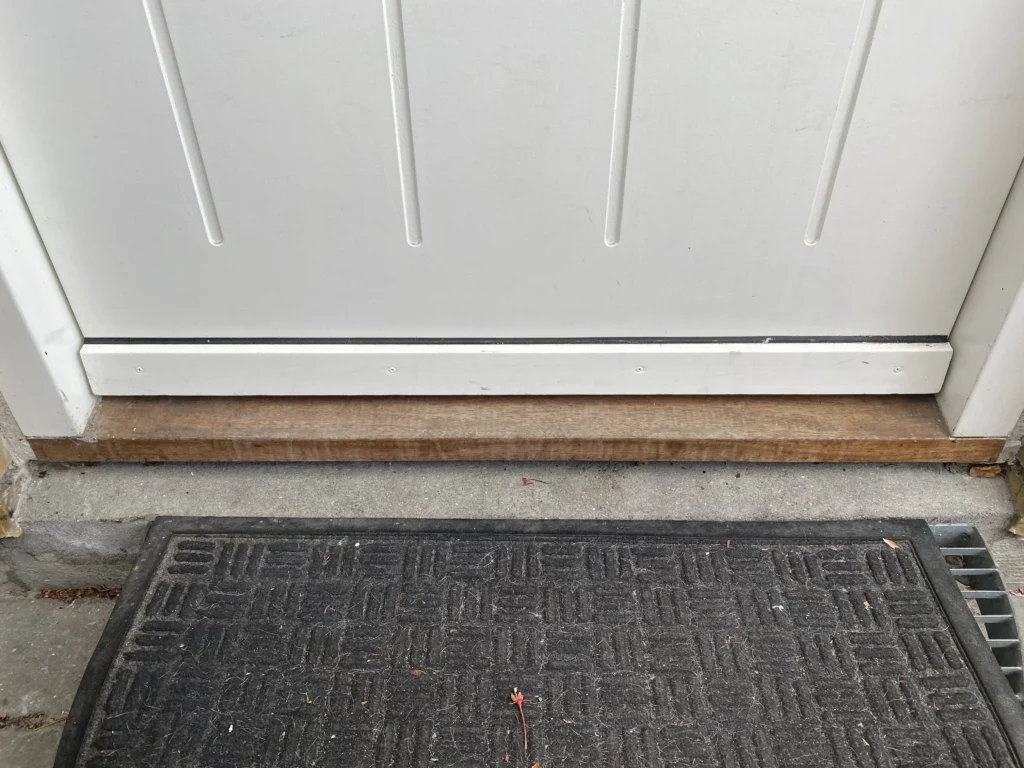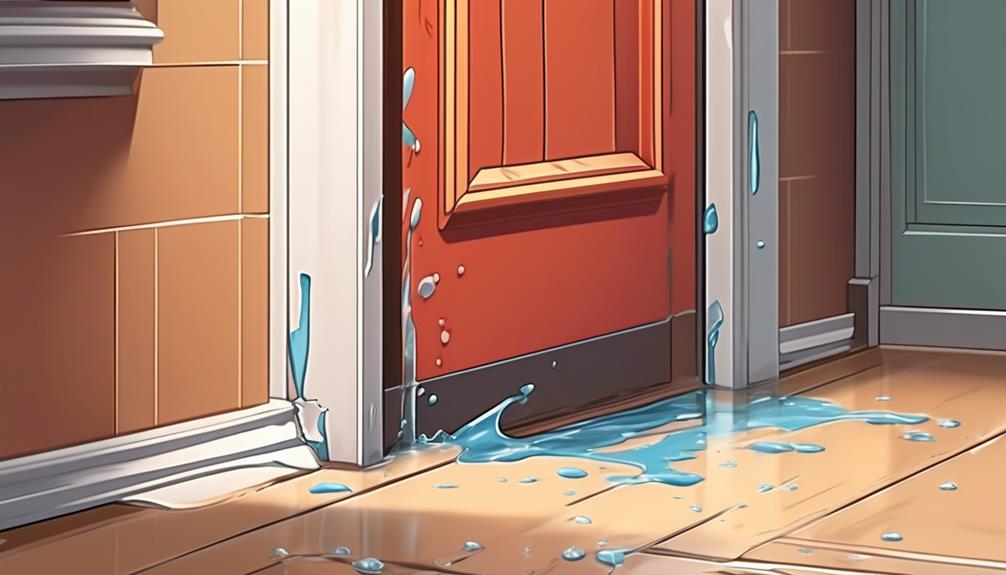Your door threshold is constantly exposed to the elements, which means it’s prone to water damage over time. But don’t worry, there’s a simple solution to waterproofing it.
By following a few steps, you can ensure that your door threshold remains secure and water-resistant.
- Start by cleaning the threshold thoroughly and removing any debris.
- Then, apply a waterproof sealant specifically designed for door thresholds. Make sure to apply it evenly and allow it to dry completely.
- Finally, regularly inspect and maintain your door threshold to catch any potential issues early on.
With these steps, you can protect your home from water damage and enjoy peace of mind for years to come.
Key Takeaways
- Assess the condition of the threshold for any visible cracks, rot, or damage to the sealant, as well as signs of moisture damage.
- Choose a high-quality waterproof sealant that is compatible with the material of the threshold.
- Properly prepare the threshold surface by removing dirt, debris, and old sealant residue, and consider sanding any rough areas.
- Apply the waterproofing sealant evenly and generously, ensuring complete filling and sealing of cracks and crevices. Regularly inspect and maintain the sealant to prevent water damage.
Assessing the Threshold Condition
Assess the condition of your door threshold by inspecting for any visible cracks, rot, or damage to the sealant. Start by checking for any signs of moisture damage, such as discoloration or warping. Use a moisture meter if necessary to assess the moisture levels in the wood.
Look for any gaps between the threshold and the door frame that could allow water to seep through. If you notice any damage, it’s crucial to repair it promptly to prevent further issues. Begin by removing any old sealant and thoroughly cleaning the area. Then, apply a new waterproof sealant to ensure a tight and secure seal.
If there are any cracks or rot, consider removing and replacing the damaged wood to maintain the threshold’s integrity. By regularly assessing and repairing any damage to your door threshold, you can effectively prevent moisture from seeping into your home and ensure a secure and dry environment.
This proactive approach will help you maintain the longevity of your door threshold and the overall condition of your home.
Choosing the Right Waterproofing Products
To effectively waterproof your door threshold, select a high-quality waterproof sealant that is compatible with the material of your threshold. Choosing the right sealant is crucial for protecting your threshold from moisture and ensuring its longevity. Below is a table to help you choose the most suitable waterproofing product for your specific needs.
| Sealant Type | Material Compatibility | Waterproofing Method | Threshold Protection |
|---|---|---|---|
| Silicone | Wood, metal, plastic | Caulking | Excellent |
| Polyurethane | Wood, metal | Sealant and adhesive | High |
| Butyl Rubber | Metal, concrete | Tape application | Good |
| Acrylic Latex | Wood, vinyl | Brush or roller | Moderate |
Preparing the Threshold Surface
Before applying the waterproof sealant, thoroughly clean the threshold surface to remove any dirt, debris, and old sealant residue.
Start by sweeping the threshold to remove loose dirt and debris. Then, use a mixture of mild soap and water to scrub the surface, ensuring all dirt and grime are removed. Rinse the threshold with clean water and allow it to dry completely before proceeding.
Next, if there are any rough or uneven areas on the threshold, consider sanding it down to create a smooth surface for the waterproof sealant.
Use a fine-grit sandpaper to gently sand the threshold, paying attention to any areas with old sealant residue or rough patches. After sanding, wipe down the threshold with a damp cloth to remove any dust created during the sanding process.
Applying the Waterproofing Sealant
Once the threshold surface is prepared, carefully apply the waterproof sealant using a paintbrush or roller, ensuring even coverage across the entire surface.
Start by applying the sealant to the edges and corners, working your way towards the center. Be thorough and methodical to ensure that every part of the threshold is properly covered. Proper application is crucial to ensure the effectiveness of the waterproof sealant.
When applying the sealant, pay special attention to any cracks or crevices in the threshold. Use a small brush or tool to work the sealant into these areas, ensuring that they’re completely filled and sealed. This will help prevent any water from seeping through these vulnerable spots.

Apply a generous, but not excessive, amount of sealant to create a strong barrier against moisture. Take your time to avoid missing any areas, and make sure the sealant is applied evenly to achieve a smooth and uniform finish.
This won’t only enhance the appearance of the threshold but also contribute to its overall waterproofing effectiveness.
Maintaining and Inspecting the Sealant Regularly
Inspect the sealant regularly to ensure its continued effectiveness in protecting the door threshold from moisture and potential water damage. Regular maintenance and inspection of the sealant are crucial for preserving its waterproofing capabilities.
Over time, the sealant may wear down due to exposure to the elements and foot traffic. By routinely checking the sealant, you can identify any areas that may require touch-ups or reapplication. Look for signs of cracking, peeling, or discoloration, as these could indicate that the sealant is no longer providing adequate protection.
Additionally, inspect the edges and corners of the threshold, as these areas are particularly susceptible to water infiltration. By staying proactive with sealant inspection, you can address any issues promptly and prevent water damage to the door threshold.
Regular maintenance and inspection not only extend the lifespan of the sealant but also contribute to the overall effectiveness of your waterproofing techniques. By incorporating these prevention methods into your routine, you can maintain a secure and watertight door threshold for years to come.
Frequently Asked Questions
How Can I Prevent Water From Seeping in Through the Sides of the Door Frame?
To prevent water seepage through the sides of the door frame, start by inspecting the threshold for any gaps or damage. Regular maintenance, such as sealing or weatherstripping, can help keep the area waterproof and protect your home.
Will Waterproofing the Threshold Affect the Appearance of the Door or Surrounding Floor?
Waterproofing the threshold can help prevent water damage and maintain its appearance. It should not significantly impact the door or floor aesthetics if done carefully. Regular threshold maintenance is essential for both functionality and maintaining a pleasing appearance.
Can I Use the Same Waterproofing Products for Both Interior and Exterior Door Thresholds?
Yes, you can use the same waterproofing materials for both interior and exterior door thresholds. The methods and materials for waterproofing are generally suitable for both, ensuring effective protection against moisture and maintaining the condition of the thresholds.
Are There Any Special Considerations for Waterproofing a Sliding Glass Door Threshold?
When maintaining a sliding door, it’s crucial to focus on the threshold. Ensure it’s weatherproofed with proper sealing and drainage systems. Regularly inspect and clean the threshold to prevent water damage and maintain functionality.
How Often Should I Reapply the Waterproofing Sealant to Ensure Maximum Effectiveness?
You should reapply the waterproofing sealant every 1-2 years to ensure maximum effectiveness. This regular maintenance will help maintain the long-term effectiveness of the sealing process and keep your door threshold protected from water damage.
watch the below video to see how you can waterproof a door threshold
Conclusion
Now that you’ve waterproofed your door threshold, you can enjoy peace of mind knowing that it’s protected from water damage.
By regularly maintaining and inspecting the sealant, you can ensure that it remains effective for years to come.
With the right products and proper application, you’ve taken an important step in preserving the integrity of your threshold and preventing costly repairs in the future.
